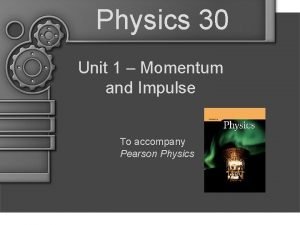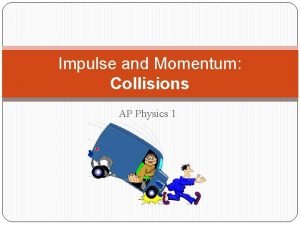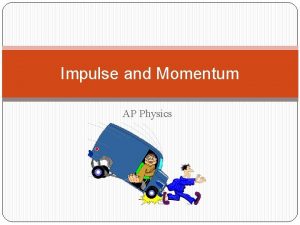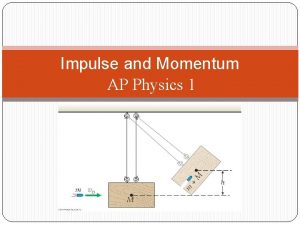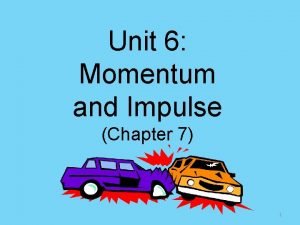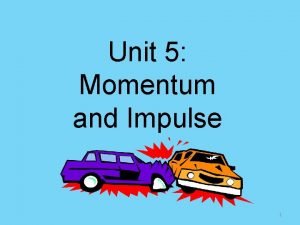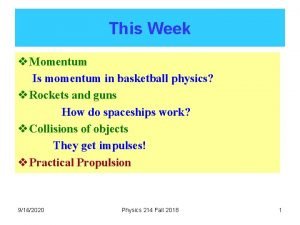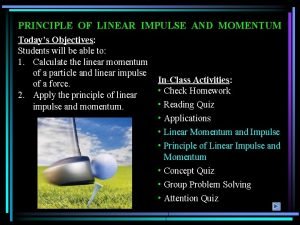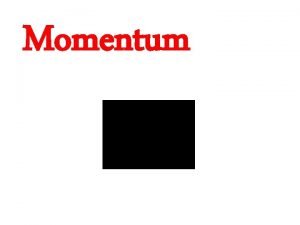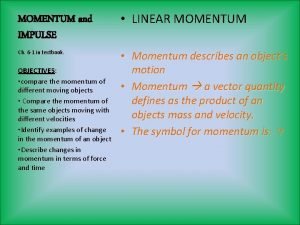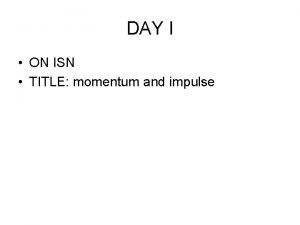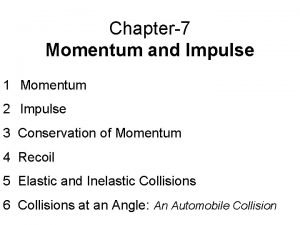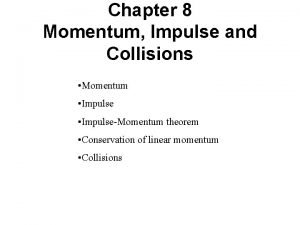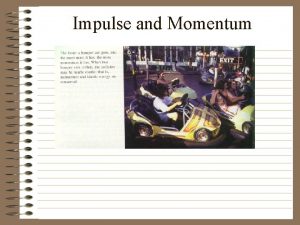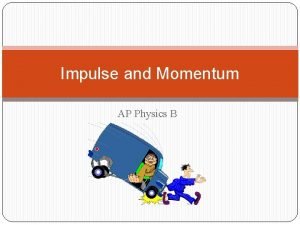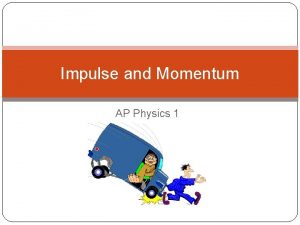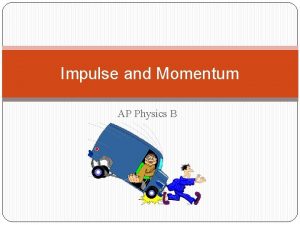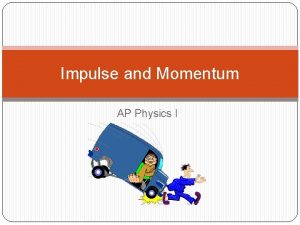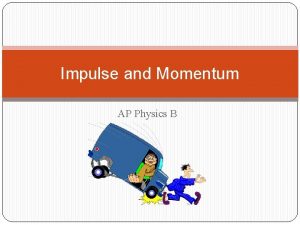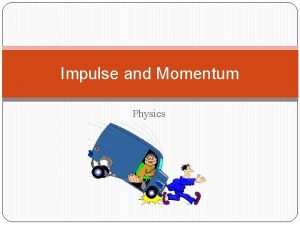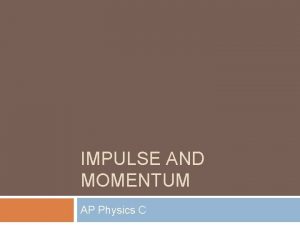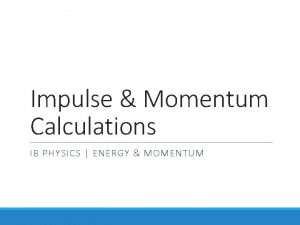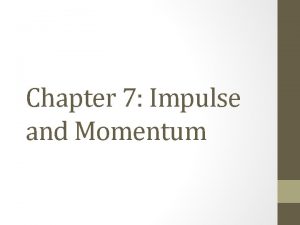PHYSICS 220 Lecture 12 Momentum and Impulse Lecture

















- Slides: 17

PHYSICS 220 Lecture 12 Momentum and Impulse Lecture 11 Purdue University, Physics 220 1

Obama’s Momentum Lecture 11 Purdue University, Physics 220 2

Impulse and Momentum • Define Momentum – Momentum is a VECTOR • Define Impulse – Change in momentum requires Force acting over a period of time or Impulse p = F t or I = p Impulse: F t Work: Fr r Lecture 11 Vector Scalar Momentum transfer Energy transfer Purdue University, Physics 220 3

Impulse and Momentum I F t = pf - pi = p impulse-momentum theorem • For single object … F = 0 momentum conserved ( p = 0) • For collection of objects … – ptotal = p – Internal forces: forces between objects in system – External forces: all other forces – Fext = 0 total momentum conserved ( ptot = 0) Lecture 11 Purdue University, Physics 220 4

1 -D F vs t Plot Impulse is simply the area under the Fx(t) curve! Lecture 11 Purdue University, Physics 220 5

i. Clicker By what factor does an object’s kinetic energy change if its speed is doubled? By what factor does the magnitude of the momentum change? A) 0. 5, 4 B) 2, 2 C) 4, 2 Lecture 11 Purdue University, Physics 220 6

Pushing Off… • Fred and Jane are on skates facing each other. Jane then pushes Fred with force F N 2 L Fred: FJF = m. Fred a = v/ t v. Fred = a. Fred t = (FJF/m. Fred) t m. Fred v. Fred = FJF t N 2 L Jane: FFJ = m. Jane a. Jane v. Jane = a. Jane t = (FFJ/m. Jane) t m. Jane v. Jane = FFJ t N 3 L: For every action, there is an equal and opposite reaction. FFJ=-FJF m. Fred v. Fred = -m. Jane v. Jane Lecture 11 Purdue University, Physics 220 7

Pushing Off… Fred (75 kg) and Jane (50 kg) are on skates facing each other. Jane then pushes Fred with a constant force F = 45 N for a time t=3 seconds. Who will be moving fastest at the end of the push? A) Fred B) Same C) Jane Fred F = +45 [N] (positive direct. ) F = -45 [N] Newton’s 3 rd law I = +45 3 [N*s] = 135 [N*s] I = -45 3 [N*s] = -135 [N*s] I = p = mvf – mvi I/m = vf - vi vf = 135 [N*s] / 50 [kg] vf = -135 [N*s] / 75 [kg] = 2. 7 [m/s] = -1. 8 [m/s] Note: p. Fred + p. Jane = (1. 8) 75 + (-2. 7) 50 = 0! Lecture 11 Purdue University, Physics 220 8

Momentum is Conserved • Define Momentum p = m v m 1 v 1 = -m 2 v 2 p 1 = - p 2 p 1+p 2) = p = 0 pinitial = pfinal Momentum is conserved p 1 f-p 1 i+p 2 f-p 2 i=0 p 1 f+p 2 f=p 1 i+p 2 i • Example: Jane pushes Fred so he is going 2. 0 m/s. If Fred is twice as heavy as Jane, how fast does Jane end up moving. pinitial = pfinal 0 = m. Fred v. Fred + m. Jane v. Jane = -m. Fred v. Fred / m. Jane = -4 m/s Lecture 11 Purdue University, Physics 220 9

Momentum is a Vector A car with mass 1200 kg is driving north at 40 m/s, and turns east driving 30 m/s. What is the magnitude of the car’s change in momentum? A) 0 B) 12, 000 C) 36, 000 D) 48, 000 E) 60, 000 pinitial = m vinitial = (1200 kg) x 40 m/s = 48, 000 kg m/s North pfinal = m vfinal = (1200 kg) x 30 m/s = 36, 000 kg m/s East North-South: p. NSfinal – p. NSinitial = (0 – 48000) = -48, 000 kg m/s East-West: p. EWfinal – p. EWinitial = (36000 - 0) = +36, 000 kg m/s Magnitude: Sqrt( p. NS 2 + p. EW 2 ) = 60, 000 kg m/s Lecture 11 Purdue University, Physics 220 40 m/s 30 m/s 10

Soft vs Hard Impact You drop an egg onto A) the floor B) a thick piece of foam rubber. In both cases, the egg does not bounce. In which case is the impulse greater? A) Floor B) Foam I = p C) the same Same change in momentum In which case is the average force greater A) Floor B) Foam C) the same Lecture 11 p = F t F = p/ t smaller t -> large F Purdue University, Physics 220 11

Bouncy vs Sticky Ball Two identical balls are dropped from the same height onto the floor. In each case they have velocity v downward just before hitting the floor. In case 1 the ball bounces back up, and in case 2 the ball sticks to the floor without bouncing. In which case is the magnitude of the impulse given to the ball by the floor the biggest? A) Case 1 p=m v = ma t = F t = I B) Case 2 C) The same Lecture 11 Bouncing Ball Sticky Ball |I| = | p| = |mvfinal – m vinitial| = |m( vfinal - vinitial)| = |m(0 - vinitial)| =2 mv = mv Purdue University, Physics 220 12

Bouncy vs Sticky Ball Two identical balls are dropped from the same height onto the floor. In case 1 the ball bounces back up, and in case 2 the ball sticks to the floor without bouncing. In both cases of the above question, the direction of the impulse given to the ball by the floor is the same. What is this direction? A) Upward B) Downward time Lecture 11 Purdue University, Physics 220 13

Question Two objects are known to have the same kinetic energy. Do these two objects necessarily have the same momentum? A) Yes B) No Lecture 11 Purdue University, Physics 220 15

i. Clicker At the instant a bullet is fired from a gun, the bullet and the gun have equal and opposite momenta. Which object has the greater kinetic energy? A) B) C) Lecture 11 The same The gun The bullet Apply conservation of momentum: Pi=0 Pf=Mgun. Vgun+mbulletvbullet Vgun=-(mbullet/Mgun)vbullet Purdue University, Physics 220 16

Outline • We have learned: Work-Energy Theorem –F = m a multiply both sides by x – F x = m a x (note: a x = ½ v 2) – F x = ½ m v 2 – W = K Defines Work and Kinetic Energy • We will learn: Impulse-Momentum Theorem –F = m a multiply both sides by t – F t= m a t (note: a t = v) – F t= m v – I = p Defines Impulse and Momentum Lecture 11 Purdue University, Physics 220 17

Newton’s Second Law New formulation of Newton’s 2 nd Law Lecture 11 Purdue University, Physics 220 18
 Physics 03-06 impulse and momentum answer key
Physics 03-06 impulse and momentum answer key Physics 30 momentum and impulse unit exam
Physics 30 momentum and impulse unit exam Ap physics momentum and impulse
Ap physics momentum and impulse Collisions ap physics 1
Collisions ap physics 1 Impulse ap physics
Impulse ap physics What is momentum in physics
What is momentum in physics Unit 6 momentum and impulse
Unit 6 momentum and impulse Unit of momentum and impulse
Unit of momentum and impulse Momentum in basketball physics
Momentum in basketball physics Linear impulse momentum equation
Linear impulse momentum equation Principle of linear impulse and momentum
Principle of linear impulse and momentum Importance of momentum
Importance of momentum Use of momentum and impulse as safety equipment in vehicles
Use of momentum and impulse as safety equipment in vehicles Which has a greater momentum a truck with a mass of 2250 kg
Which has a greater momentum a truck with a mass of 2250 kg Importance of momentum and impulse
Importance of momentum and impulse Impulse momentum
Impulse momentum Conservation of momentum in sports
Conservation of momentum in sports Units of momentum
Units of momentum

